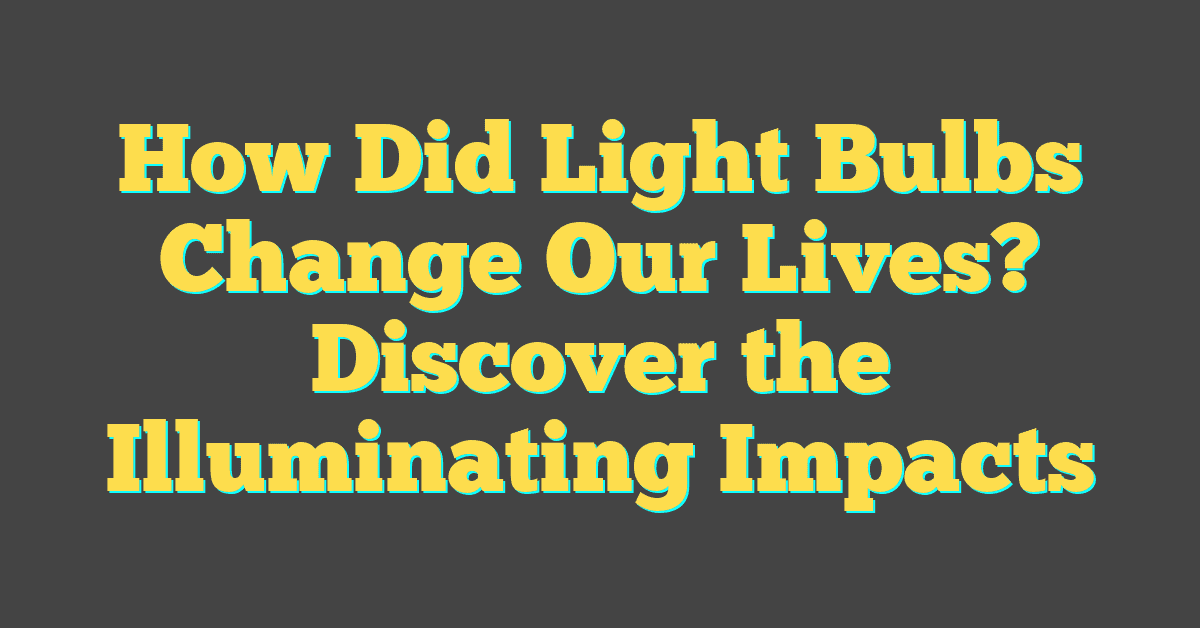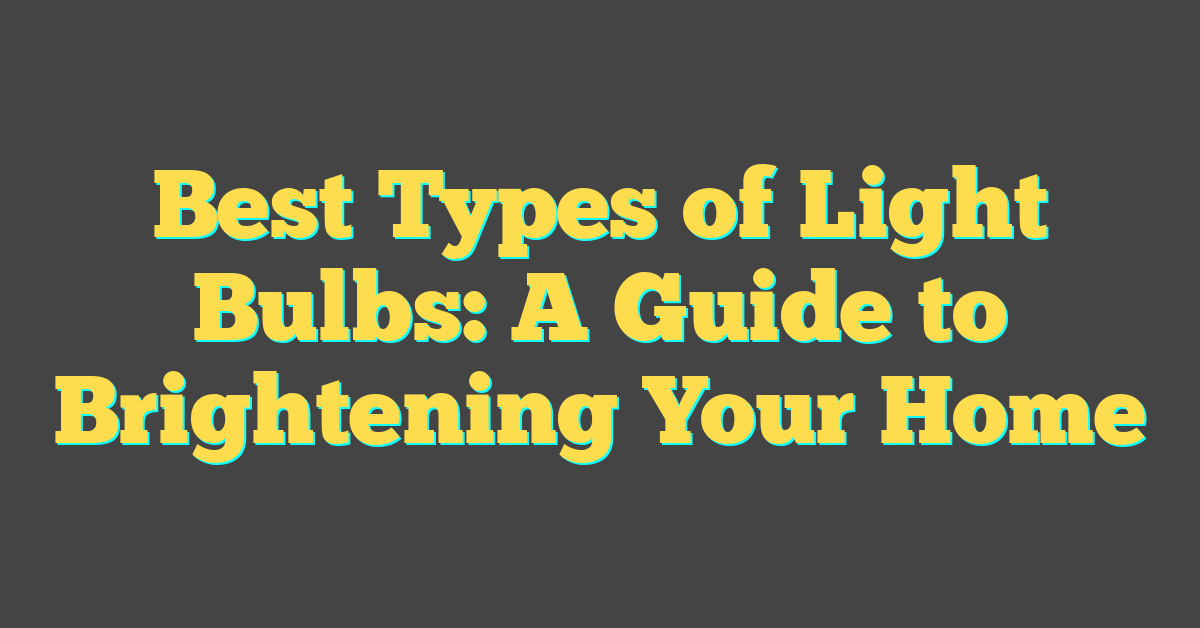Imagine life without the warm glow of a light bulb. You’d be relying on candles or gas lamps, stumbling in the dark after sunset. Sounds pretty inconvenient, right? Well, that was the reality before light bulbs came along and revolutionized the way you live and work.

The invention of the light bulb didn’t just chase away the darkness; it sparked a cultural and economic transformation. It extended your days, boosted productivity, and even changed the way you socialize. Let’s flip the switch and illuminate the profound impact light bulbs have had on your everyday life.
The Invention of the Light Bulb
Imagine life without the convenience of flipping a switch and banishing darkness with a single, simple action. Before the invention of the light bulb, your evenings were capped by the setting sun, productivity hobbled by the availability of daylight. The era of candles and gas lamps posed not only a hassle but a hazard, with open flames threatening safety and consuming valuable resources. Then came a pivotal moment in human history: the advent of the light bulb.
The journey to that quintessential a-ha moment wasn’t a straight path. It was a collaborative effort, with early iterations and inventions by Humphry Davy, Warren De la Rue, and Joseph Swan. But it was Thomas Edison who ultimately brought the vision to a commercially viable reality. In 1879, Edison introduced a bulb that used a carbon filament, casting a glow that would flicker on into the future and make him a household name.
As you’re often keen to tackle your latest home DIY project, it’s fascinating to think about how the light bulb itself has evolved. From carbon filaments, the industry moved to tungsten, which proved to last longer and shine brighter. The evolution didn’t stop there: you’ve seen the rise of compact fluorescents and, more recently, LEDs, which have revolutionized energy efficiency and bulb longevity.
- Early Light Sources
- Key Inventors
- Evolution of Filaments
Each step forward in the technology of light bulbs has been more than just a practical advancement—they’ve been milestones in the way you shape and experience your environment. From Edison’s early glow to the bright, cost-effective LED lights you can now install on your own, the path of progress shines a light on human ingenuity and our relentless pursuit to make life not just easier, but better.
Extending the Day

Imagine life without the sun’s rays reaching the corners of your home, keeping your activities strictly timed by the clockwork of natural light. Before the invention of the light bulb, that’s exactly how things were. You only had so many hours in a day to work, read, or play. Electric lighting changed all that. It’s like having a mini-sun in every room that you can switch on whenever you fancy. With the gift of artificial light, your day no longer ends at sunset.
Think about your evening routines: cooking, reading, or enjoy some late-night DIY projects. These wouldn’t be possible without the humble light bulb illuminating your space. It has allowed for vast improvements in productivity and leisure, giving rise to entirely new industries and forms of entertainment. Businesses too could extend their working hours and thus, their output. This flexibility has been nothing short of revolutionary for the working world.
Moreover, your safety at night has improved drastically. Street lighting has made nocturnal commutes less hazardous and public spaces more accessible after dark. Just think back to the last time you walked your dog after nightfall or returned from a late shift. That sense of security is due in no small part to the bright lamps that line our streets and sidewalks.
As lighting experts will tell you, the right kind of light can make all the difference in your home. The warm glow of incandescent bulbs might make your living room cozier while the bright, clear light of LEDs is perfect for task lighting in your workshop or crafting area. Not only can you extend your day, but you can also tailor the quality of your artificial daylights to your exact needs and moods.
The evolution from oil lamps to LED has been less about simply pushing back the night, and more about expanding what we can do with our time. It’s hard to imagine how many great ideas and projects have been realized because the light bulb gave us the luxury to burn the midnight oil, quite literally, in the comfort of our homes. So next time you flip a switch and banish the darkness, remember you’re not just lighting up a room; you’re unleashing the potential of what you can do with every added hour the light bulb grants you.
Boosting Productivity

Imagine it’s late in the evening and you still haven’t crossed everything off your must-do list. Before the light bulb, you’d be out of luck. But now, you flip a switch and voila, you’ve got hours of potential productivity ahead. This is what light bulbs brought to the table: the ability to extend the working day beyond the sunset.
Artificial light has revolutionized workspaces, both at home and in offices. It’s not just about enabling longer hours; it’s about the quality of that light. Harsh lighting can lead to eye strain and fatigue, while softer, adjustable lighting can keep you focused and comfortable during those marathon DIY project sessions.
« Why Is the Light Bulb So Important? Unveiling Its Role in Entertainment Magic
Do I Have to Replace Light Bulbs Before Moving Out? Essential Tips & Etiquette »
Studies have shown that proper lighting can increase productivity and even boost your mood. In places like factories or assembly lines, targeted, bright light reduces errors and improves speed. In your home office, a well-placed desk lamp could mean the difference between squinting at your computer screen and breezing through your task list.
Entrepreneurial ventures have greatly benefited, too. Backyards and garages have turned into workshops thanks to powerful, energy-efficient LEDs. Here’s the kicker: they’re not just bright; they’re customizable. With lighting systems that you can control right from your smartphone, the perfect ambiance for any project is just a tap away. Ever considered a dimmable LED strip for your workbench? You should.
Light bulbs aren’t just a household essential. They’re your silent partner in the quest to finish that passion project, cram for a test until midnight, or launch that start-up you’ve been dreaming of. Let’s shed some light on a few key points:
- Proper lighting can lead to improved work performance.
- Adjustable lighting is key to customizing your work environment.
- Smart lighting systems have taken personal productivity to a whole new level.
What’s more, the choices available now are almost endless. From the warm glow of incandescent bulbs rekindling a vintage vibe to the sharp, daylight mimicry of modern LEDs, you can tailor your light landscape to fit exactly what you need—whether that’s a cozy reading corner or a high-precision assembly area.
Improving Quality of Life

Imagine coming home from a long day of work. You flip a switch and immediately, your living space transforms from a shadowy enclosure to a warm, inviting habitat. This is the everyday magic that light bulbs bestow upon us. It’s not just about vision; it’s about creating an ambiance that resonates with your mood and enhances your well-being.
Let’s delve into how your humble light sources shape your quality of life on a daily basis:
- Mood Enhancement: You’ve probably noticed how your mood changes with lighting. A dimly lit room can be soothing, while a brightly lit office can boost your alertness. Studies show that proper lighting can even alleviate symptoms of depression and anxiety. It’s all about finding the right balance that suits your emotional and mental needs.
- Health Benefits: Exposure to natural light is known to regulate vitamin D levels, critical for bone health and immune function. While artificial light can’t entirely replace sunlight, it certainly helps in maintaining a consistent light exposure, especially during the darker months or for individuals with limited access to natural light.
- Interior Design and Functionality: You’re aware that great lighting is at the heart of any brilliant home DIY project. It’s transformative. Strategic placement of light can highlight your favorite decor pieces, make small rooms appear larger, or create a focus area for those late-night reads or intricate hobby work. Task lighting has become a game-changer, offering targeted illumination that aligns perfectly with function and aesthetics.
- Smart Homes and Efficiency: The evolution of smart bulbs has given you unbelievable control over your home environment. With a smartphone or a voice command, you adjust brightness, color temperature, and power your lights on or off. The energy efficiency of modern LEDs also means you’re saving on utility bills, while reducing your carbon footprint. These high-tech bulbs can last for years, significantly reducing the hassle and frequency of replacements.
Every flip of the switch has the power to tailor an environment perfectly suited to your needs, whether you’re diving into a new book, setting the mood for a dinner party, or working away in your home workshop. The possibilities are virtually limitless, and as a lighting aficionado, you certainly appreciate the subtleties of this impressive evolution.
Changing Socialization Patterns

With the advent of the light bulb, social activities extended well past sunset. Prior to this, evening gatherings were limited by dwindling daylight, but artificial lighting has essentially abolished the constraints of night. Now, your celebrations, study groups, and dinner parties can last as long as you wish.
Remember how in historical novels characters would retire early? That’s hardly the case nowadays. Evening hobbies and pastimes have flourished under the warm glow of incandescent and LED bulbs. Imagine trying to complete a DIY project or knit by candlelight; tedious at best! Modern lighting has made such activities effortlessly accessible any time you choose.
The evolution of light has also transformed public social spaces. Restaurants, theaters, and shopping centers rely on strategic lighting to create ambiances that attract and retain customers. As a light bulb connoisseur, you might have noticed how lights set a scene that encourages people to linger, interact, or feel a certain way.
In terms of home design, lighting has gone from utilitarian to a form of self-expression. Installing different types of light fixtures can shape the atmosphere of a room and influence the social interactions within. A cozy, dimly-lit living room with strategically placed floor lamps invites intimate conversations whereas bright, well-lit spaces encourage a more lively and open dialogue.
Even public safety and community engagement have been impacted. Safer, well-lit streets encourage nighttime socializing and events, fostering a sense of community. Thanks to lighting, festivals and night markets have become staples in many cultures, drawing crowds and boosting local economies.
Moreover, the introduction of smart lighting systems has simplified the way you orchestrate social gatherings at home. With a few taps on your smartphone, you can adjust lighting to suit the mood of your event, whether you’re throwing a vibrant party or hosting a relaxed book club.
The influence of light bulbs on socialization is profound indeed. As this technology continues to advance, it’s exciting to think of the new ways it may further refine how we come together and interact in shared spaces.
Conclusion
It’s clear that the humble light bulb has done more than just illuminate our nights. You’ve seen how it’s extended your days, influenced your mood, and even transformed the way you socialize. With each leap from carbon filaments to LEDs, you’ve witnessed a revolution not just in technology but in lifestyle. Your home, your work, and your community are all brighter and more connected thanks to this brilliant invention. So the next time you flip a switch, remember you’re not just shedding light on your surroundings—you’re tapping into a legacy of innovation that continues to shape your world in countless ways.
Frequently Asked Questions
Who were the key inventors involved in developing the light bulb?
The key inventors involved in the development of the light bulb included Humphry Davy, Warren De la Rue, Joseph Swan, and Thomas Edison.
How has the light bulb filament evolved over time?
Light bulb filaments have evolved from carbon to tungsten, leading to improvements in efficiency and longevity.
What impact has the light bulb had on productivity?
The invention of the light bulb has extended the workday, improved safety, and increased productivity and leisure possibilities, greatly benefiting personal and entrepreneurial productivity.
How does the light bulb improve quality of life?
Light bulbs enhance mood, provide health benefits, contribute to interior design, facilitate smart home automation, and have revolutionized how we socialize by allowing for activities to continue after sunset.
What advancements have been made in light bulb technology beyond the traditional incandescent bulb?
Advancements in light bulb technology have included the development of compact fluorescents, LEDs, and smart lighting systems that offer customizable lighting options.




